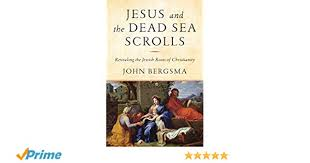Part Four: Matrimony, Celibacy, and the Scrolls
Bergsma opens chapter 9 by noting the widespread fallacy that the ancient Jews did not practise celibacy (125), for the Essenes in fact did (129-132). Further, in Matthew 19, Our Lord speaks of contemporary men who were celibate for the kingdom of God (125-126). Apart from the effort that other, non-Essene Jews, had practised celibacy, priests had observed “a kind of periodic celibacy” (128-129). The reason for the Essene embrace of celibacy was that: “… marital relations rendered one unclean, and the Qumranites never wanted to be unclean! They aspired to “perfect holiness” – and cleanliness, while not the same as holiness, was a prerequisite for holiness,” an understanding confirmed by the Damascus Document (132). As an aside, my own view is that ‘another order of Essenes” who do in fact marry, and are mentioned by Josephus, may be the Therapeutae (133, 144-145).
The Qumran community saw itself as a substitute temple, and a “Holy of Holies for Aaron,” (134). This was the early Christian view of themselves, too; and like the Essenes, linked sexual purity to maintaining status as the temple (135). The Christian Church both valued celibacy and allowed marriage (136). Interestingly, married priests were sometimes criticised for not being celibate within their marriages (137). The valuation of celibacy and singleness led to the valuation of monasteries and the monastic life (138).
In chapter 10, Bergsma observes that, in Israel, in the Lord’s time: “Everyone agreed that sex should only take place within marriage …” but that there were disputes as to divorce (141), and that Jesus took a position even “more conservative” than that of the most conservative Jewish school, that of Shammai which permitted divorce only for grave acts of impurity such as adultery, while the school of Hillel would allow it even because the man wanted a younger and more attractive wife (142). The Lord’s position corresponded only to that of the Essenes, who, like Jesus: “… reject the plain sense of the law of Moses in order to go back to earlier biblical texts that represent “the principle of creation” … (and) point to the same text that Jesus cites: “male and female he created them” (Gen. 1:27) (143-144)”
Bergsma then speaks of how some Essenes were said to have allowed marriage for the sake of posterity, and this position is that of the Book of Tobit (145-147). This leads to the reflection that the Catholic and Orthodox Churches have more books in their Scriptures than the Protestants, and that the Essenes seem to have considered scriptural texts such as the Book of Jubilees and 1 Enoch, books which the Ethiopian Orthodox Church consider biblical (145-146).
After considering New Testament teachings on marriage in their ancient context, Bergsma observes that the DSS use for marital union and covenant the word yahad, the word they use for the covenant community of Qumran (154): “One can see that the fact that the Qumran group constituted a yahad bound together by a holy covenant, (suggesting that) there is a kind of mystical relationship between the sacred covenant community as a whole and each married couple. The two “covenant communities” reflect or mirror one another (154).”
The parallel to St Paul’s teaching in Ephesians 5 is duly highlighted (155), with the observation that: “Like the older Israelite Scriptures, neither the Scrolls nor Paul ever commands husbands to make their wives submit. Both exhort wives to do so of their own free will” (156). St Paul goes further than the others in desiring that the husband love his wife as himself, and likening the marital covenant to that which the Lord has with the Church, so that we are members of His body (156). The effect of this teaching is that: “Matrimony takes on a new significance as a sacred symbol, or icon, of the new covenant. For this reason Paul refers to it as a “mystery,” Greek mysterion, which in Latin becomes sacramentum … This Ephesians 5:32 could be translated, “This sacrament is a profound one, and I am saying that it refers to Christ and the Church.” Not all Christians recognise matrimony as a sacrament, but somewhat ironically it is the only one of the traditional Christian sacraments to be called a “sacrament” in Scripture (157).”
He then makes the very important point that some see a contradiction between the Christian and also the Essene endorsement of marriage and of celibacy together. It may be a paradox (an apparent contradiction), but there is no real opposition: “… there (is) an inner logic to it: since matrimony (is) so good in itself, to give it up for the sake of the kingdom of heaven (is) a very noble sacrifice (157).”
Bergsma ends this chapter noting that, unlike pagan culture, the Church demanded fidelity and exclusivity not only from the wife but also from the husband, and that women were seen as partners in a covenantal commitment, partners “in whom a man could find a relationship of completion and wholeness that participated in divine love, God’s own nature” (157-158).
Joseph Azize, 13 November 2019
